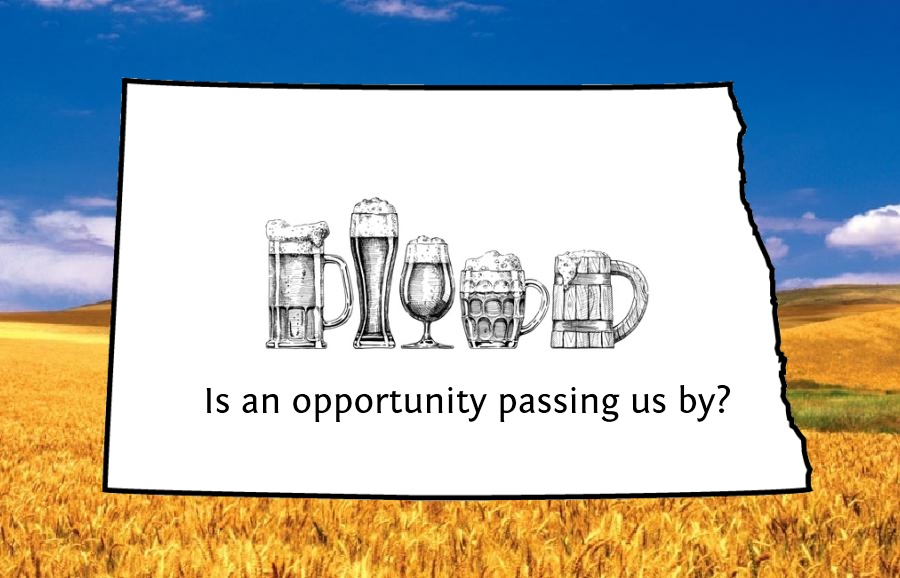What you’re about to read is an argument for change. It’s an argument for changing an entrenched mindset. It’s an argument for changing an entrenched business model. And it’s an argument for changing some seriously entrenched laws.
Most importantly, it’s an argument about beer.
But before I get to the actual arguing, I’d like to establish what I’ll call ‘the facts’. Here’s the thing though, I don’t know them to be actual facts — I discovered them on the Internet which forces us to question them. But for the purposes of my argument, it’s not important that they be 100% accurate — we need ‘the facts’ so we can set-up our measuring stick.
So here are ‘the facts’ that I’ll use to set-up our measuring stick so that I can make an argument about beer.
- In North Dakota, we drink a lot of beer. According to this article, North Dakotans over the age of 21 each drank approximately 43 gallons of beer in the year 2013. If you run the math from gallons to ounces to 12-ounce beers — 43 gallons equals about 460 beers.
- In North Dakota, we spend a lot of money on beer. To keep our math simple, let’s assume that each of those beers cost $1.00. That means each of us over the age of 21 spent about $460 on beer in 2013. Those are ‘on average’ numbers.
- In North Dakota, according to 2013 Census estimates there were 500,349 of us over the age of 21.
- So, if there were 500,349 of us and we each spend on average $460 on beer, that means we spent about $230 million on beer in 2013.
- By and large, the popular beer flavors in North Dakota are from the Budweiser and Coors families. And though we may argue which of those brands tastes better, the one point that is not up for debate — we send a lot of the money we spend on beer to St. Louis and Colorado.
- In North Dakota, we don’t always drink our beer in the healthiest, most responsible fashion — at least according to these statistics regarding our tendency towards binge drinking.
So, now that we have our measuring stick, here’s my argument:
We could dramatically change the culture of small town North Dakota for the better, we could add more money to our small town economies, we could create a new, local market for our raw agricultural products, we could create an industry of opportunity for our young people, and we could maybe even improve on our not-so-healthy culture of drinking.
And I believe we could do it all by creating a business friendly climate for a new breed of brewers and breweries. Let me break it down for you.
A Cultural Center in Every Small Town is a Reason to Travel
Local breweries are unique. Craft beer is the product of creative thinking, industrious tinkering, and adherence to ritualistic technique. The varieties and flavors that arise in a craft brewing culture are infinite. As much as I love them both in certain circumstances, Bud Light is not unique, Coors light is not unique. I will never in my life travel more than a mile to find either, but I have already found myself planning trips across the country focused on tasting truly inspired beer. Imagine the tourism opportunity created by a statewide, small town brewery tour — each town with a unique flavor to offer an intrepid traveler.
An Economic Multiplier of Local Dollars
With locally owned breweries, 100% of dollars spent on beer would stay in small towns; we wouldn’t be shipping 50% of the cost of every beer directly out of state. Our hard earned dollars would stay in our communities; they would get spent and respent. They would get taxed and retaxed. The impact on municipal budgets, local investment, and jobs would be significant. Don’t believe me? Look at the example set by Howard, South Dakota — a small town that started a ‘buy local’ campaign almost 20 years ago. The results have been incredible.
A New Local Market for Farmers
Think for a minute about the ingredients that go into beer. Water, barley, hops, yeast, wheat — you get it right? Beer is made mostly from raw agricultural products — we already grow those things! And the best part about craft brewers (from a farmer’s perspective), they care about ingredients. It means there’s an opportunity for the small, niche farmer who’s focusing on quality and variety. There’s an opportunity to grow a product that is different, better, and more valuable! And our farmers wouldn’t have to deal through a middleman either because the end consumer is right down the street. It all adds up to a better financial return for farmers on efforts already being put forth.
An Industry of Opportunity for Our Kids
For as long as I can remember, politicians and leaders have talked about the need to hang on to our kids. We’ve witnessed generations of out-migration of our greatest asset — our young people. The reason sold to us is always, “there are no jobs or opportunity.” While I disagree that ‘opportunity’ is the sole reason kids leave North Dakota, I do believe it is a factor. So, here’s an opportunity to create opportunity. Here’s an opportunity to create jobs. And these are not flash in the pan natural resource jobs. The breweries of Germany and Belgium have been sustaining communities for what is now approaching a millennium. Don’t believe me? Here’s your proof.
A Healthier Culture of Alcohol?
Here’s where my argument steps into the land of conjecture. My points above are well founded in anecdotal evidence, but what might the impact of a shift from a Bud and Coors culture to a craft brew culture be? Might it possibly be a shift to healthier drinking habits? I use observation of my own behavior to inform my thinking.
When I sit and enjoy a local brewery beer, the way I drink and think about what I’m doing changes. With craft beer, I’m more conscious of the fact I’m drinking alcohol because the beer is stronger and the alcohol content is widely advertised. It forces me to acknowledge the latent cost associated with each next beer. Plus, I enjoy the beer more. I savor it. The end result — I drink less and make better decisions.
For those keeping score, that’s a net-net improvement in public health — I’m healthier because I’m drinking less, everyone else is healthier because I’m less of a hazard to them. Like I said, this is pure conjecture. My personal behavior does not indicate or predict a cultural shift. But what if it did? What if I wasn’t unique?
How Do We Get to This Locally Brewed Utopia?
If you’re the cynical, political type, you’re probably expecting me to start talking about tax incentives and spending by economic development associations. Well, sorry to disappoint you — I don’t think that’s the answer. The key to encouraging this shift is simple — we need to get out of the way.
The evolution toward a craft brewed culture is already happening, but a system of laws put in place more than 80 years ago is holding things up. Our laws install a three-tier system made up of manufacturers (brewers), distributors, and retailers. The system is a byproduct of the prohibition era corruption that was rampant in the liquor business. But the necessary laws of 1930’s North Dakota are delivering unintended consequences in 2015 North Dakota.
North Dakota’s laws — our laws — force small, upstart brewers to shoot off a hand before they start brewing. By that I mean we force brewers to give up a revenue source, give up an opportunity to make money, give up an opportunity to be profitable. And when laws make it harder for new, small businesses to be profitable, we’re going to see fewer of them. That isn’t conjecture; that’s economics.
Now, I’m not going to bore you with the intricacies of our state’s brewing laws. That will come at a later point, but I will say this — in the recent sessions, legislators have been working towards making our laws more friendly to the brewing industry. But more can be done. And considering what I believe is a significant opportunity — more should be done. We need to make it easier for the little brewer so they are encouraged to take risks and invest in our communities.
The Time to Act is Now
There’s a saying about trees that goes like this — the best time to plant a tree is 20 years ago, the second best time to plant a tree is today. It’s the same with building a brewing industry. The action we take today won’t be visible for a generation — But if we start now, we can still make North Dakota an early leader in the cultural revolution towards craft beer rather than a follower fighting for scraps.
Full Disclosure — My Personal Interest in the Brewer’s Reformation
And now it’s time you know fully where I’m coming from. Everything I’ve written above I believe, but I also have a financial interest in starting this conversation. Though we’re not yet brewing, I am an owner in a brewery interest. The Minot Voice is taking longer to become a viable business than I can afford, so I had to divert for a period to put some reliable income in place.
That income will come (I hope) from selling a few t-shirts and hopefully, eventually, some beer for a sorta silly, somewhat offensive brewery concept that is equal parts North Dakota self-deprecating and theologically thought-provoking. If you like t-shirts that start conversations, we can probably find you one that fits.
It’s less than a church but more than a brewery — it is the Protestant Brewing Company. Check it out here, act quick if you want a t-shirt in time for Christmas!




I would have to disagree with you as to the benefits that it would have on the agriculture industry. Tale SRB for instance, I suspect that it would be pretty hard for them to use 160 acres worth of barley or wheat in a year. To my knowledge they don’t have the storage for it either. The other thing is on the plus side they are an end user, on the bad side they are a small end user. I doubt that they can afford to pay the premiums that the elevators give us, let alone out bid the elevators. Same goes for them against the local wheat mill in Minot. It would also not be in heir best interest to have a contract with a single farmer, I remember in the last ten years how the vom levels in barely was so bad that Budweiser was rejecting a lot of truck loads of grain and in the last couple of years wheat had such a bad disease problem that farmers were talking about burning fields.
It would be many years before it would have any kind of really noticeable impact. Right now yes they are adding another market for grain to go, but it’s like dropping a pebble into the ocean. It will be many years before it turns into dropping a pebble into a river.
Hi Shawn,
I wouldn’t disagree with any of your points. Taken today, it would only be a drop in the bucket, but new markets rarely open as a river. They grow because they provide value to an end user. But what might it become in 25 years? There is a revolution in beer that’s already underway, and a lot of the raw ingredients that go into beer are grown right here. And I think when we can trade locally what we grow locally, we’ll be better off.
Thanks for reading!